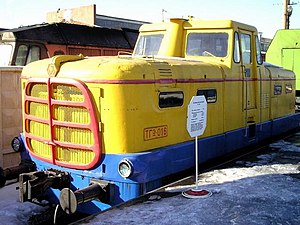SŽD series ТГэ
| SŽD series ТГ э SŽD series МГ3 |
|
|---|---|
|
ТГ э .016
|
|
| Numbering: | ТГ э .001–022 МГ3.001–008 |
| Number: | ТГэ: 22 МГ3: 8 |
| Manufacturer: | Jenbacher works |
| Year of construction (s): | 1958-1959 |
| Axis formula : | C. |
| Gauge : | 1520 mm |
| Smallest bef. Radius: | 80 m |
| Empty mass: | 46 t |
| Service mass: | 48 t |
| Friction mass: | 48 t |
| Wheel set mass : | 16 t |
| Top speed: | Creep speed : 10 km / h Line speed: 80 km / h Shunting speed : 30 km / h |
| Installed capacity: | 441 kW (600 hp) |
| Starting tractive effort: | Creep speed: 117.5 kN Shunting speed: 100 kN |
| Wheel diameter: | 900 mm |
| Motor type: | IW-600 |
| Motor type: | 12-cylinder two-stroke diesel engine |
| Rated speed: | 1,500 rpm |
| Power transmission: | hydraulic |
| Tank capacity: | 1,650 l |
The locomotives of the SŽD series TГ э (German transcription TG E ) of the Soviet Railways (SŽD) are wide-gauge diesel locomotives with diesel-hydraulic power transmission primarily for shunting and construction train service. They go back from the construction to the ÖBB 2064 and were produced in the Jenbacher works . Since they differ significantly from the ÖBB 2064 in terms of the box structure, they should also be described separately. As a special feature, they have a hydrodynamic power transmission with a three-converter gearbox, whereby one converter is intended for a crawler gear with speeds of up to 10 km / h. Another special feature is that they have an electrical power supply for the operation of route management and construction machinery. In the USSR their number was rather insignificant, it was only 22 for the TГ э and eight for the МГ3 .
TГ э
Due to the special nature of the energy supply for the operation of route management and construction machinery, the TГ э is also referred to as a diesel locomotive electric station. It was built by Jenbacher Werke from 1958 to 1959 on the basis of a special order from the Ministry of Transport of the former USSR .
The entire drive system was housed in the front part of the vehicle and the fuel tank in the rear.
The diesel-electric drive system was created with many components from the previously supplied small diesel locomotive SŽD series МГ2 , which was derived from the ÖBB 2062 . Again a two-stroke diesel engine was used. Compared to that of the ÖBB 2062, the number of cylinders has been increased from eight to twelve, increasing the output from 294 kW (400 PS) to 441 kW (600 PS). The fluid transmission L 24 UKG from Voith differed from the fluid transmission L 24 of the SŽD series МГ2 by an additional third converter for driving with the crawler gear. The locomotive had a reduction and reversing gear SWV 24 after the fluid transmission to switch between shunting, route and change of direction. From this gearbox, the torque was transmitted to the axle drives and axles using cardan shafts.
The locomotive had a three-phase generator (designation Fl 326 / 23-4 ) with an output of 300 kW for the electrical supply of the route management machines . The generator for the power supply of the locomotive, the compressor for the compressed air supply, the heater and the boiler for heating the driver's cab were designed as in the small motorized locomotives МГ1 and МГ2 .
The small locomotive had a respectable starting tractive effort of 117.5 kN when crawling. In the shunting gear, the pulling force was 100 kN at 10 km / h and 31 kN at 30 km / h. The maximum speed was set at 60 km / h, 80 km / h were possible for transfers.
МГ3
The МГ3 machine was also produced by the Jenbacher works . In the USSR they appeared in 1958. It differed from the diesel locomotive electric station in the lack of a three-phase generator for powering external devices.
Received vehicles
One locomotive, the TГ э .016 , has been preserved and can be seen in the Railway Museum of the October Railway in Saint Petersburg .

